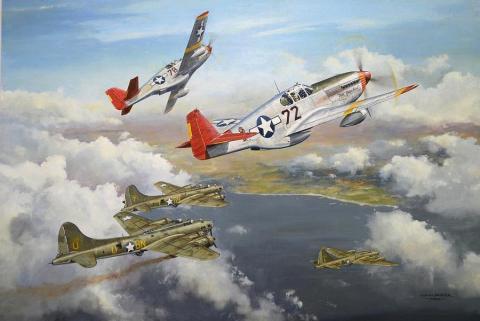Colin Parker created this painting depicting Lt. Lee Archer flying his "Red Tail" Mustang P-51C. Archer, a Tuskegee Airman, is escorting a squadron of B-17f bombers flying a mission in Europe during WWII. Prints of this work are available for purchase via Fine Art America. Copyright Colin Parker, all rights reserved. Image provided here as fair use for educational purposes and to acquaint new viewers with Parker's work.
Knowing that his men needed to work hard and produce results, Col. Davis returned to Europe as commander of the 332nd Fighter Group. To avoid repositioning from forward combat to a rear area, his pilots needed to wrack-up impressive statistics.
One of their supporters was Lt. General Ira Eaker, senior American airman in the Mediterranean area. It was his opinion that "90 percent of the trouble with Negro troops was the fault of the whites."
Col. Davis knew, however, that whatever opinions anyone had about fault (or lack thereof), nothing counted as much as results. His pilots' own actions would decide their fate, and they had been through a really bad dry spell. In six months of flying nearly 1,400 sorties, during 225 missions, they hadn't downed a single German plane.
It was time for a radical change. The Tuskegee airmen needed orders to fly where German planes were lurking, then take them out. When those orders came, the pilots did not disappoint their leader, Col. Davis:
- Members of the 99th (now called a "Fighter" instead of a "Pursuit" Squadron) participated in "Operation Shingle," the attack on Anzio, Italy (before they joined the 332nd Flighter Group). Flying P-40 Warhawks, they took-out twelve enemy planes between the 27th and 28th of January, 1944. One American pilot was also lost.
- After moving to Ramitelli - located on the Adriatic side of Italy, near Termoli - the 332nd received new planes. Now flying P-51 Mustangs (in addition to P-47 Thunderbolts), they could provide up to sixty-four pilots for escort missions. It was at Ramitelli where they met Toni Frissell (the famous photographer), painted the tails of their planes red and sometimes shared the runway with local goats.
- Assigned to the 15th U.S. Army Air Force, black pilots of the 332nd Fighter Group provided escort services to seventeen Bomber Groups. Those bomb crews (usually numbering ten or eleven per plane) flew B-17s ("Flying Fortresses") and B-24s ("Liberators").
- Escorting bombers - during long-distance air raids over France, Germany, Yugoslavia, Austria, Romania and Greece - became the 332nd's primary responsibility. During two days in March of 1944, black pilots flying P-51s shot-down twenty-five German fighters.
White bomber pilots began to notice that red-tailed planes were providing effective escort help. They did not "peel away," to engage German fighters, leaving the bombers unprotected. They did not appear to be searching for individual glory. Soon bomb crews referred to the 332nd pilots as "Red-Tailed Angels."
During March of 1945, Allied bombers undertook a long and dangerous mission to Berlin. They had to fly about 1600 miles to reach the Daimler Benz tank factory near the German capital. Led by Colonel Davis himself, until his plane developed engine trouble before reaching Berlin, the Red Tails escorted the bombers on the round-trip journey.
The flight to Berlin was relatively uneventful until the bombers neared the target. Suddenly, unbelievably fast German planes approached the Americans. They were Messerschmitt 262s - jets, in other words - which could fly at least 100 miles an hour faster than their opponents.
Although speed gave an ME- 262 the advantage, it also gave it less maneuverability. The Red Tails were able to down three 262s - which were made underground, largely by slave labor from a nearby concentration camp - during the successful bomb run to Berlin.
Because of their incredible escort performance, during the long trip to Berlin, everyone in the 332nd received a Presidential Unit Citation.
By the end of the war, African-American pilots of the 332nd Fighter Group had accumulated impressive statistics:
- Exploding one Italian-Destroyer-turned-German-Torpedo ship (in the Adriatic Sea, near Trieste);
- Shooting-down 109 planes in the air (including the three ME-262 jets);
- Destroying more than 140 German and Italian planes on the ground.
In the process, the Group lost sixty-six pilots who were killed in action and more than thirty pilots who became prisoners of war (after bailing-out over enemy territory).
Who were these men who answered TIME magazine’s question:
Is the Negro as good a soldier [or pilot] as the white man?


 Back
Back
 Next Chapter
Next Chapter

 Back
Back
 Next Chapter
Next Chapter



